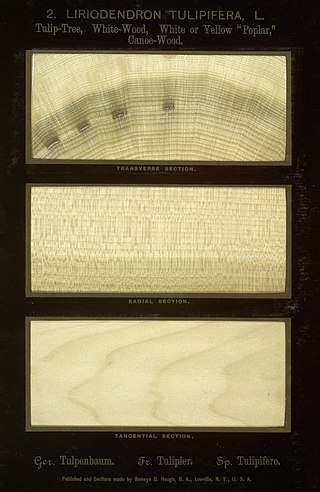
Most commonly, tulipwood is the greenish yellowish wood yielded from the tulip tree, found on the Eastern side of North America and a similar species is found in some parts of China. In the United States, it is commonly known as tulip poplar or yellow poplar, even though the tree is not related to the poplars. It is notable for its height, which can exceed 190 feet. The wood is very light, around 490 kg per cubic meter, but very strong and is used in many applications, including furniture, joinery and moldings. It can also be stained very easily and is often used as a low-cost alternative to walnut and cherry in furniture and doors.

Harpullia is a genus of about 27 species of small to medium-sized rainforest trees from the family Sapindaceae. They have a wide distribution ranging from India eastwards through Malesia, Papuasia and Australasia to the Pacific Islands. They grow naturally usually in or on the margins of rainforests or associated vegetation. Plants in the genus Harpullia are usually dioecious shrubs or trees covered with simple or star-shaped hairs. The leaves are paripinnate and the flowers are usually arranged in leaf axils, usually with 5 petals, 5 to 8 stamens and a 2-locular ovary. The fruit is a 2-lobed capsule.

Diploglottis australis, known as the native tamarind, is a well known rainforest tree of eastern Australia. It is easily identified by the large sausage shaped leaflets.

Cupaniopsis anacardioides, commonly known as tuckeroo, cashew-leaf cupania, carrotwood, beach tamarind or green-leaved tamarind, is a species of flowering plant in the family, Sapindaceae, and is native to eastern and northern Australia. It is a tree with paripinnate leaves with 4 to 8 egg-shaped leaflets with the narrower end towards the base, or elliptic leaves, and separate male and female flowers arranged in panicles, the fruit a more or less spherical golden yellow capsule.

]]
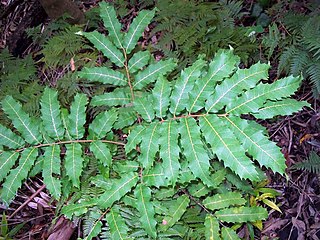
Cupaniopsis newmanii is a rainforest plant in the soapberry family. It is native to eastern Australia. The common name is long-leaved tuckeroo. A rare plant, with a ROTAP listing of 2RC-. The habitat is subtropical rainforest ranging from Mullumbimby in New South Wales to Gympie in south-eastern Queensland.

Harpullia frutescens, commonly known as dwarf harpullia, is a species of flowering plant in the family Sapindaceae, and is endemic to North Queensland. It is a shrub with paripinnate leaves with 6 to 8 leaflets, white flowers with a pink tinge, and crimson capsules containing 2 seeds with a yellow aril.

Lepiderema pulchella, commonly known as fine-leaved tuckeroo, is a species of flowering plant in the family Sapindaceae and is endemic to coastal eastern Australia. It is a tree with pinnate, glossy light green leaves with four to fourteen leaflets, panicles of yellow-orange flowers and brown, spherical to three-lobed fruit.

Austrocallerya megasperma, one of several species commonly known as native wisteria, is a species of flowering plant in the family Fabaceae and is endemic to eastern Australia. It is a woody climber with pinnate leaves and racemes of purple, pea-like flowers.

Harpullia arborea, commonly known as Cooktown tulipwood in Australia, is species of flowering plant in the family Sapindaceae is native to the Indian subcontinent, Sri Lanka throughout Mainland Southeast Asia and Malesia to Queensland in Australia and the Western Pacific. It is a tree with paripinnate leaves with 6 to 10 leaflets, small pink or pale green flowers arranged in leaf axils or on old woody stems, and orange-yellow to red capsules containing shiny black seeds.
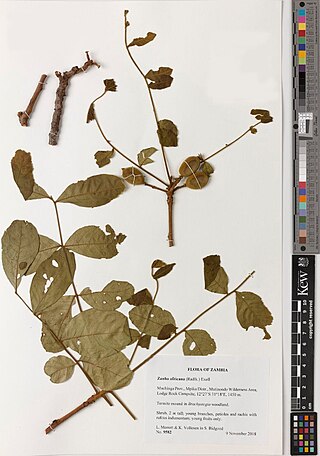
Zanha africana, commonly known as the velvet-fruited zanha in English and as mkalya or mkwanga in Swahili, is a species of plant in the family Sapindaceae that is native to Africa. It is used locally for timber and herbal medicine.
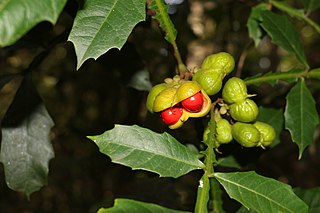
Harpullia alata, commonly known as winged tulip or wing-leaved tulip, is a species of flowering plant in the family Sapindaceae, and is endemic to eastern Australia. It is a tree with paripinnate leaves, the leaflets elliptic with teeth on the edges, white flowers and capsules containing a seed with a yellow to reddish aril.

Harpullia leichhardtii is a tree in the family Sapindaceae, endemic to the Northern Territory.

Diploglottis harpullioides, commonly known as Babinda tamarind, is a rainforest tree in the lychee and maple family Sapindaceae which is found only in northeast Queensland, Australia.

Harpullia ramiflora, commonly known as the Claudie tulipwood or Cape York tulipwood, is a tree in the Sapindaceae family native to north east Queensland, New Guinea and parts of Malesia.

Harpullia rhyticarpa, commonly known as slender harpullia, is a plant in the family Sapindaceae which is endemic to the rainforests northeastern Queensland, Australia.

Diploglottis diphyllostegia, commonly known as the northern tamarind, native tamarind or wild tamarind, is a tree in the lychee family Sapindaceae which is endemic to Queensland, Australia. It is an attractive tree with potential in cultivation, with a dense crown of dark green leaves and masses of fruit in spring and summer.
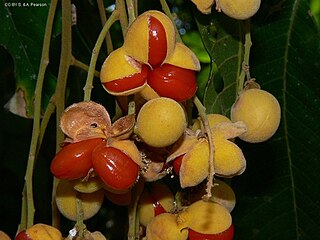
Diploglottis obovata, commonly known as blunt-leaved tamarind, is a plant in the family Sapindaceae endemic to central eastern Queensland, Australia. Until 1987 it was considered to be a form of the very closely related Diploglottis diphyllostegia.
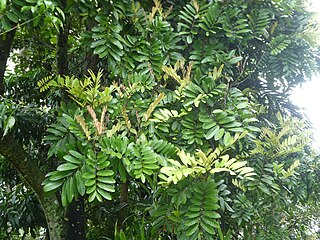
Diploglottis alaticarpa is a plant in the maple and lychee family Sapindaceae which is endemic to northeast Queensland, Australia. It was first recognised as a distinct species in 1994 and was formally described in 2014.

Cupaniopsis foveolata, commonly known as narrow-leaved tuckeroo, white tamarind or toothed tuckeroo, is a plant in the maple and lychee family Sapindaceae found in eastern Queensland and New South Wales, Australia.




















